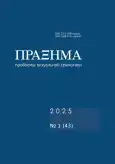Видеоигры в мультимодальной оптике (размышления над книгой Hawreliak J. «Multimodal Semiotics and Rhetoric in Videogames»)
- Авторы: Беляев Д.А.1
-
Учреждения:
- Липецкий государственный педагогический университет имени П.П. Семенова-Тян-Шанского
- Выпуск: № 1 (2025)
- Страницы: 181-199
- Раздел: РЕЦЕНЗИИ
- URL: https://journal-vniispk.ru/2312-7899/article/view/291931
- DOI: https://doi.org/10.23951/2312-7899-2025-1-181-199
- ID: 291931
Цитировать
Полный текст
Аннотация
Ключевые слова
Об авторах
Дмитрий Анатольевич Беляев
Липецкий государственный педагогический университет имени П.П. Семенова-Тян-Шанского
Email: dm.a.belyaev@gmail.com
доктор философских наук, доцент, профессор кафедры философии Липецк, Россия
Список литературы
- Белов 2022 – Белов С. И. Историческая символика видеоигр как фактор коррекции социальной памяти населения (на материалах франшизы Assassin’s Creed) // Диалог со временем. 2022. № 79. С. 228–235. doi: 10.21267/AQUILO.2022.81.81.017
- Беляев 2023 – Беляев Д. А. Мультимодальная и медиалингвистическая дискурс-аналитика видеоигр (размышление над книгой Astrid Ensslin “The Language of Gaming”. Basingstokeand New York: Palgrave Macmillan, 2012. 208 p.) // Научный результат. Социальные и гуманитарные исследования. 2023. Т. 9, № 3. С. 187–193. doi: 10.18413/2408-932X-2023-9-3-0-14
- Беляева, Копаница 2023 – Беляева У. П., Копаница В. Ю. Концепт-образ Советского Союза в видеоигре «Atomic Heart»: альтернативно-историческая реконструкция // Современные исследования социальных проблем. 2023. Т. 15, № 1-3. C. 29–34.
- Загидуллина 2023 – Загидуллина М. В. Современное состояние мультимодального анализа: к вопросу о перспективах метода // Научный результат. Социальные и гуманитарные исследования. 2023. Т. 9, № 1. С. 84–99. doi: 10.18413/2408-932X-2023-9-1-0-7
- Мойжес 2020 – Мойжес Л. В. Анализ идеологического потенциала видеоигры с точки зрения теории аффордансов Джеймса Гибсона // Социология власти. 2020. Т. 32, № 3. С. 32–52. doi: 10.22394/2074-0492-2020-3-32-52
- Пстыга 2021 – Пстыга А. Мультимодальность медиатекста в новом коммуникативном пространстве (наблюдения и замечания) // Вопросы журналистики, педагогики, языкознания. 2021. Т. 40, № 4. С. 442–450. doi: 10.52575/2712-7451-2021-40-4-442-450
- Черный 2017 – Черный С. Ю. Конструирование прошлого в видеоиграх: игрок как потребитель и соавтор исторического нарратива (проект «Europa Universalis 4») // Шаги / Steps. 2017. № 3. С. 77–97.
- Abousnnouga, Machin 2008 – Abousnnouga G. Machin D. The Visual Institutionalization of Discourses in War Monuments // Language and Power: An Introduction to Institutional Discourse / ed. Andrea Mayr. London; New York: Continuum, 2008. P. 115–137.
- Belov 2024 – Belov S. I. Reflecting the Cold War in “Atomic Heart” // Science Journal of Volgograd State University. History. Area Studies. International Relations. 2024. Vol. 29, № 1. P. 26–33. doi: 10.15688/jvolsu4.2024.1.3
- Bogost 2007 – Bogost I. Persuasive Games: The Expressive Power of Videogame. Cambridge, MA: MIT Press, 2007. doi: 10.7551/mitpress/5334.001.0001
- Boluk, LeMieux 2017 – Boluk S., LeMieux P. Metagaming: Playing, Competing, Spectating, Cheating, Trading, Making and Breaking Videogames. Minneapolis: University of Minnesota Press, 2017. doi: 10.5749/j.ctt1n2ttjx
- Ensslin 2012 – Ensslin A. The Language of Gaming. Basingstoke and New York: Palgrave Macmillan, 2012.
- Forceville 2009 – Forceville C. Non-verbal and multimodal metaphor in a cognitivist framework: Agendas for research // Multimodal Metaphor. Berlin: Mouton de Gruyter, 2009. P. 19–42. doi: 10.1515/9783110197761.5.379
- Gee 2013 – Gee J. P. Proactive design theories of sign use: Reflections on Gunther Kress // Multimodality and social semiosis: Communication, meaning, and learning in the work of Gunther Kress. New York: Routledge, 2013. P. 43–53. doi: 10.4324/9780203761090
- Hawreliak 2013 – Hawreliak J. Heroism, Gaming, and the Rhetoric of Immortality. PhD. Waterloo, Ontario, 2013.
- Hawreliak 2018 – Hawreliak J. Multimodal Semiotics and Rhetoric in Videogames. New York; London: Routledge, 2018.
- Kromhout, Forceville 2013 – Kromhout R., Forceville C. Life Is a Journey: Source-Path-Goal Structure in the Videogames “Half-Life 2”, “Heavy Rain”, and “Grim Fandango” // Metaphor and the Social World. 2013. Vol. 3, is. 1. P. 100–116. doi: 10.1075/msw.3.1.05for
- Murray 1997 – Murray J. Hamlet on the Holodeck: The Future of Narrative in Cyberspace. New York: Simon and Schuster, 1997.
- Noris 2004 – Noris S. Analyzing Multimodal Interaction: A Methodological Framework. Routledge, 2004.
- Sutton-Smith 2001 – Sutton-Smith B. The Ambiguity of Play. Boston: Harvard University Press, 2001.
- Toh 2015 – Toh W. A Multimodal Discourse Analysis of Video Games: A Ludonarrative Model. PhD. National University of Singapore. 2015.
- Toh 2019 – Toh W. A Multimodal Approach to Video Games and the Player Experience. New York; London: Routledge, 2019.
- Tyazhlova et al. 2021 – Tyazhlova Y., Manokhin D., Kozhemyakin E., Srybnyy D. Multimodal Rhetoric of Acute Media Text // Media Education (Mediaobrazovanie). 2021. Vol. 17, № 1. P. 144–152. doi: 10.13187/me.2021.1.144
- Wilcox 2014 – Wilcox S. Procedural Realism: The Political Representation of Reality in Videogames // First Person Scholar. 2014. November. URL: http://www.firstpersonscholar.com/procedural-realism/
Дополнительные файлы







